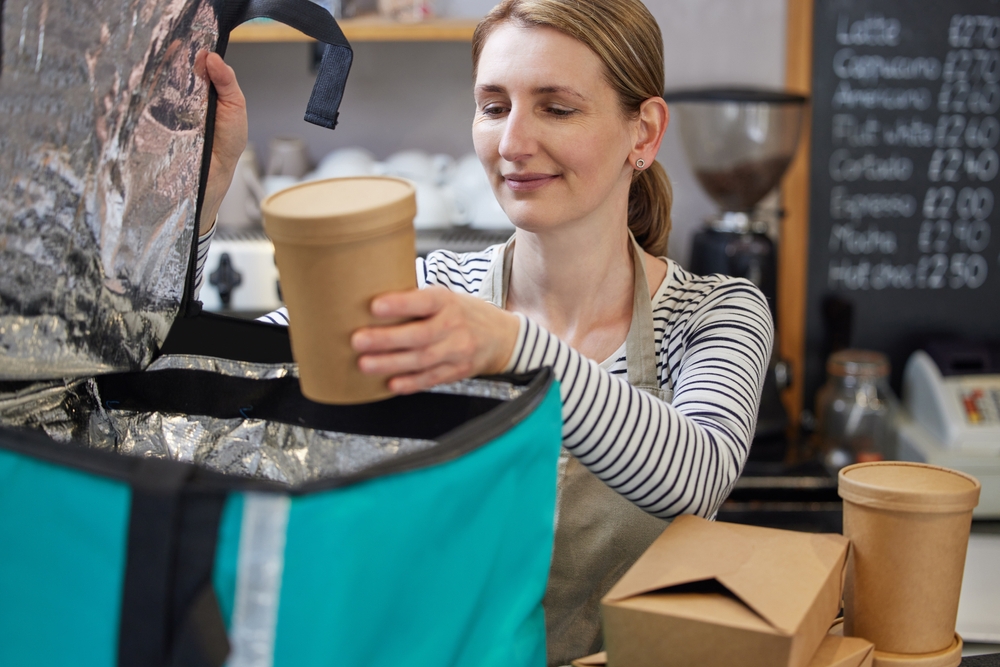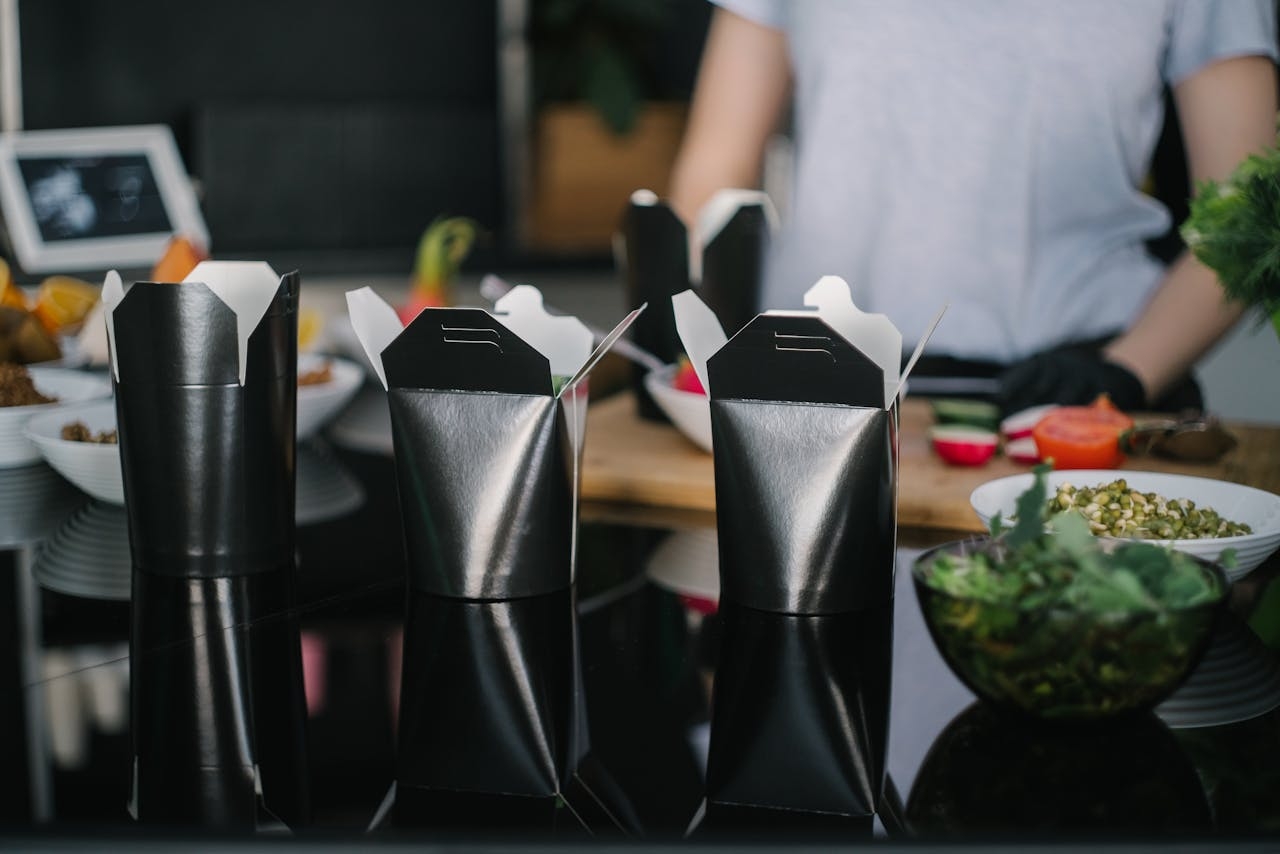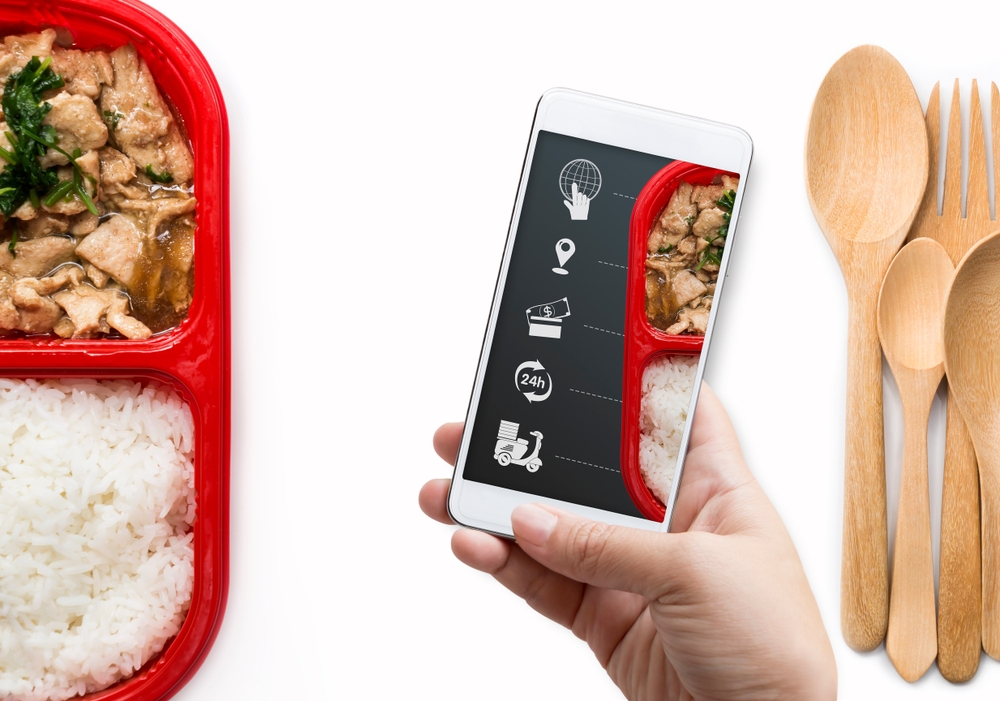Embracing Sustainability: Mapping the Future of Takeaway Packaging Trends
By Morten Numrich · 2. April 2024
As we step into the future of takeaway packaging, it stands at the forefront of a sustainability revolution.
This article zeroes in on the materials and technologies heralding a new era for food on the go, addressing the urgent shift to minimize ecological footprints.
With a spotlight on breakthroughs in bioplastics and recycling♻️, get ready to unpack the industry’s pivot towards an environmentally friendly future.
Evolving Consumer Preferences and the Demand for Sustainable Takeaway Packaging
 Female Restaurant Worker Using Sustainable Takeaway Packaging
Female Restaurant Worker Using Sustainable Takeaway Packaging
Previously, the focus of takeaway food packaging was purely on convenience.
However, the rise in environmental awareness and the growing understanding about the harmful impact of packaging waste have led to a significant shift in consumer preferences.
Presently, the environmental impact of packaging influences the purchase decisions of over 60% of consumers in the UK.
This shift has brought about a demand for sustainable takeaway packaging that goes beyond just being a container for food.
Currently, product packaging holds a significant place in telling a brand’s story and serves as a portable billboard, fostering a genuine connection with customers by enhancing the brand’s narrative and outreach.
This connection evokes a positive emotional response in consumers and informs them about the product and sustainability efforts of the businesses.
Therefore, brands that adopt sustainable packaging practices not only contribute to a greener future but also leverage this as a powerful marketing tool, turning it into an effective sales pitch to differentiate themselves in the market.
Environmental Awareness
The shift in consumer preferences is largely driven by increasing environmental awareness and concerns over the negative environmental impact of traditional packaging disposal.
Plastics, once hailed as the miracle material for its versatility, durability, and low cost, are now being viewed as problematic due to their associated environmental issues.
These growing concerns have led to an increased demand for biodegradable single-use packaging.
Businesses that adopt sustainable packaging practices not only reduce their carbon emissions but also enhance their brand image and reputation by using eco-friendly materials and energy-efficient production processes.
This alignment with consumers’ values and societal expectations is a key driver in the shift towards sustainable packaging.
Health and Safety Concerns
The problems associated with traditional petrochemical plastics used in food packaging extend beyond environmental issues to include health and safety concerns.
These plastics pose potential health risks as they persist in the environment for centuries, contributing to pollution and generating microplastics that can enter the food chain.
This direct concern for human health has raised questions about the safety of such packaging materials.
The COVID-19 pandemic has further highlighted the importance of effective packaging in ensuring hygiene safety and reducing virus transmission risks.
This has led to an increased demand for packaging that can not only protect the integrity of the food but also ensure its safe delivery to the consumer.
Innovative Materials Transforming Takeaway Packaging
 Innovative Paper Takeaway Boxes
Innovative Paper Takeaway Boxes
In light of evolving consumer preferences and environmental concerns, the takeaway food industry is beginning to investigate the use of innovative materials for packaging.
These materials aim to:
- Reduce environmental impacts
- Reduce plastic waste
- Conserve resources
- Minimize food waste
Biodegradable and compostable packaging options, such as bioplastic made from plants, are increasingly being adopted for takeaway purposes.
Similarly, materials like Virgin Kraft board are being used for takeaway containers to manage both hot and cold food items effectively while being resistant to leaks and grease.
These innovations are transforming the landscape of takeaway packaging, leading us towards a future where the food we enjoy doesn’t come at the cost of our planet’s health.
Biodegradable Materials
The use of biodegradable materials in takeaway packaging offers several benefits:
- Reduces environmental impact
- Conserves finite petroleum reserves
- Presents a solution to waste disposal problems associated with traditional petroleum-derived packaging.
Products such as:
- Dissolvable packing peanuts
- Biodegradable air pillows
- Cocoform packaging using coconut fiber
- Bagasse containers
leverage biodegradable properties to create sustainable and eco-friendly takeaway packaging options.
Moreover, plant-based biodegradable plastics such as PLA are gaining attention for food packaging due to their reduced environmental impact and ability to degrade without leaving harmful residues.
The adoption of these materials is in line with market trends towards sustainability and caters to consumer preferences, adding value to businesses by differentiating their products.
Renewable Resources
The employment of renewable resources represents another thrilling evolution in takeaway packaging.
Composites made from biopolymers and natural fibers or fillers from agricultural waste can lead to the development of green composites, which not only enhance performance but also mitigate environmental impact in food packaging applications.
Innovative💡 materials like bioplastic, which utilizes 50 per cent of its composition from industrial chocolate production waste, offer a vegan, biodegradable, water-repellent, and washable solution for takeaway packaging.
Similarly, Piatex fabric, derived from pineapple leaf fibers, provides a pliable, breathable, and water-resistant material that serves as an eco-friendly alternative to traditional synthetic materials in packaging.
Such innovations are paving the way for a future where takeaway packaging is not just eco-friendly but also resource-efficient.
Leading Brands Embracing Sustainable Practices
Although these innovations show promise, what really counts is their acceptance within the market.
Fortunately, major fast-food brands like McDonald’s, Subway, and Burger King are leading the way in this regard.
They are not just embracing sustainable packaging practices but also setting benchmarks for others to follow.
By implementing these practices, these leading brands are not only reducing their environmental impact but also meeting the growing consumer demand for sustainable practices.
Their efforts showcase that sustainability and profitability are not mutually exclusive but can go hand in hand with the right approach.
Packaging Strategies for a Greener Future
 Compostable Packaging
Compostable Packaging
The adoption of sustainable packaging practices extends beyond simply meeting consumer demand or adhering to regulations.
It can also lead to:
- Cost savings
- Improved operational efficiencies
- Waste reduction
- Resource conservation
For instance, using recyclable, compostable, or recycled-content materials can play a significant role in achieving these benefits.
Moreover, businesses can differentiate themselves in the market and appeal to eco-conscious consumers by selecting renewable, recyclable, and compostable packaging materials.
This transition to a greener packaging approach aligns with the growing market expectations and the global shift towards sustainability.
Differentiation through Sustainability
Sustainability as a point of differentiation isn’t merely a marketing strategy; it reflects a business’s values and its dedication to caring for the environment.
By adopting sustainable packaging strategies, businesses can stand out in the market, appeal to environmentally conscious consumers, and foster innovation in materials and design.
Brands that utilize sustainable packaging can attract a broader customer base and strengthen their reputation as industry leaders in environmental and social responsibility.
Some key strategies for implementing sustainable packaging include:
- Sourcing local materials
- Staying ahead of regulatory compliance on environmental standards
- Aligning the company’s values with employees’ preferences for a responsible employer
By implementing these strategies, businesses can differentiate themselves and demonstrate their commitment to sustainability.
Aligning with Market Trends
Market trends are another key factor influencing packaging strategies.
Over 60% of global customers consider the environmental impact of packaging when making purchases, indicating a strong market trend towards sustainable packaging and the importance of packaging design for target customers.
To align with these trends, businesses must prioritize the use of sustainable packaging materials such as bioplastics and recycled paper.
By adopting sustainable packaging, companies can stay ahead of evolving sustainability standards and regulations, which is increasingly important in the current market trends.
This alignment not only drives efficiency but also increases the overall value of the brand in the eyes of the consumers.
The Role of Technology in Shaping the Future of Takeaway Packaging
 smart takeaway packaging
smart takeaway packaging
Looking forward, technology is expected to have a significant influence on the future of takeaway packaging.
Some ways in which technology is enhancing takeaway packaging include:
- Integration of modern technology in takeaway packaging
- Rise of smart packaging
- Enhancing the marketing appeal of takeaway food packaging
- Improving user experience and convenience
- Shaping consumer perceptions of takeaway food packaging
Technology is not just about digital interactions; it’s also about material innovations.
By adopting biobased packaging materials and leveraging technological advancements for their production and biodegradation, the industry is affirming its commitment to sustainability.
QR Codes and Digital Interactions
QR codes, one of these technological advancements, have become a potent tool for boosting both consumer engagement and sustainability objectives.
By reducing the need for physical printed materials, QR codes contribute to saving on paper, plastic, and ink.
Brands are using QR codes to share their stories, including the quality of their products, their sourcing practices, and more, thereby enhancing consumer engagement.
Additionally, QR codes on food packaging can educate consumers about ingredients, health benefits, and the origin of the product, thus providing transparency and building trust.
Innovations in Material Development
While digital interactions are bringing about a revolution in the consumer experience, advancements in material development are altering the physical nature of packaging, including physical packaging.
Biobased packaging utilizing natural resources like bamboo🎋 and seaweed has gained popularity due to its biodegradable characteristics.
Innovative solutions like Notpla’s Ooho, a seaweed-coated packaging that offers recyclable and compostable qualities, demonstrate a sustainable alternative to traditional plastic containers.
These innovations are a testament to the industry’s commitment to sustainability and a glimpse into the future of takeaway packaging.
Case Studies: Successful Sustainable Packaging Examples
Observing these innovations in action can offer genuine inspiration.
Let’s look at some case studies of businesses in the takeaway food industry that are successfully implementing sustainable packaging solutions.
These examples showcase how businesses are not just talking about sustainability but actively implementing it.
From fast-food chains that switched from traditional plastic toys in their children’s meals to items made from a sustainable material to juice bars that replaced their plastic straws with biodegradable ones, businesses are finding innovative ways to reduce their packaging waste and contribute to a greener future.
Bagasse Clamshell Containers
The use of bagasse clamshell containers is a noteworthy instance of sustainable packaging.
Made from the by-product of sugarcane, these containers utilize what would otherwise be waste.
Compared to traditional polystyrene packaging, bagasse clamshell containers are 100% plastic-free, do not absorb oil and water, and can be composted after use, thus offering significant environmental advantages.
Bioplastic Cups
Another prime example of sustainable packaging is the use of bioplastic cups and plastic bottles, made from PLA (polylactic acid).
These containers are derived from plant materials instead of fossil fuels and can break down in a commercial composting facility within 12 weeks.
Summary
Sustainability in takeaway packaging is more than just an industry trend; it’s an essential response to evolving consumer preferences and environmental concerns.
From biodegradable materials and renewable♻️ resources to innovative💡 technologies and market trends, the landscape of takeaway packaging is undergoing a significant transformation.
As we move towards a greener future, it’s clear that businesses, big and small, have a pivotal role to play.
By embracing sustainable practices, leveraging technology, and aligning with market trends, businesses can not only reduce their environmental impact but also enhance their brand identity, meet consumer demand, and contribute to a more sustainable world.
Frequently Asked Questions
What are the recent advances in food packaging technology?
Food packaging technology has come a long way, with advancements like time-temperature indicators and modified atmosphere packaging leading to improved food quality, safety, and shelf life. Embrace these innovations to make your food last longer and stay fresher.
How does takeaway packaging affect the environment?
Takeaway packaging can have a negative impact on the environment due to the use of materials like plastic, styrofoam, aluminium, and cardboard, which can contribute to landfills and environmental issues. It’s important to consider eco-friendly packaging alternatives to reduce this impact.
What are the 5 P’s of packaging?
The 5 P’s of packaging are: Promote, Position, Present, Provide, and Protect. Don’t underestimate the power of packaging when it comes to promotion!
What is causing the shift in consumer preferences towards sustainable packaging?
Consumers are increasingly opting for sustainable packaging due to rising environmental consciousness and worries about the effects of traditional packaging disposal. Additionally, concerns about health and safety, especially post the COVID-19 pandemic, have highlighted the demand for effective and hygienic packaging. Stay savvy about the eco-friendly shift!
What are some examples of innovative materials used in takeaway packaging?
Innovative materials in takeaway packaging include biodegradable options like bioplastic and bagasse containers, as well as renewable resources such as biopolymers and natural fibers from agricultural waste. Embrace sustainability in your packaging choices!

